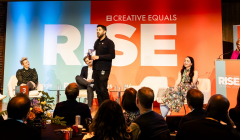
Are we leaving men and boys behind?
At Creative Equal’s RISE event, industry leaders consider how to reframe boys and men in marketing

M&C Saatchi's breakfast panel in partnership with Queer Britain explored LGBT+ representation in culture and why it matters for the industry.

Adeline Servais, Marketing Manager at Levi Strauss & Co has urged brands to reappraise their approach to LGBT+ representation.
Speaking at a panel discussion at M&C Saatchi this morning, Servais lifted the lid on the brand’s approach to LGBT+ representation, urging other brands, “If you don’t do it for the right reasons, don’t do it.”
She revealed that the fashion giant constantly challenges itself to ensure its message is authentic. She explained, “It is not about the product; it is not about the brand. We do not profit from our Pride line. We are doing it for the right reason; it comes from the heart.”
100% of the proceeds from Levi’s Pride clothing line is going to OutRight Action International, which is working to advance human rights for LGBT+ people across the globe.
Levi’s also has an ongoing partnership with Queer Britain, which aims to establish the UK’s first LGBT+ museum. To mark Pride 2019, the brand has launched a photography exhibition entitled Chosen Family. The exhibition will present a collection of stories and images which, according to the brand will “celebrate the diversity and uniqueness of the LGBT+ experience and community.”
Joseph Galliano, Founder and CEO of Queer Britain, urged the audience to question whether brands are simply replacing one stereotype with another. Recalling his tenure editing Gay Times, he said, “We would be excited when we had finally secured advertising with a prestigious car brand, only to have our hearts sink when we saw another topless white man next to a car with a rainbow flag.”
We would be excited when we had finally secured advertising with a prestigious car brand, only to have our hearts sink when we saw another topless white man next to a car with a rainbow flag.
Joseph Galliano
The panel discussed the focus of LGBT+ brand activity around Pride, with Servais noting that representing the LGBT+ community doesn’t stop in August. “We want to support the community throughout the year,” she explained.
Noting that even in some of the brand’s European territories such as Russia Pride is illegal, she urged brands to remain focused on the challenges that still need to be overcome. However, in the midst of criticism of corporate brands at Pride, Servais noted that Levi’s presence this year will all be made through supporting their LGBT+ community partners, as oppose to investing in a standalone corporate presence.
Tanya Compas, who does youth engagement for UK Black Pride and is a freelance writer for gal-dem highlighted the tangible actions from brands such as ASOS and Dr. Martens, who have gifted products to the community, without looking for corporate profile in return, as examples of good practice.
Compas also highlighted a recent campaign with Absolut vodka as an example of how brands should engage with the LGBT+ community. According to Compas, the campaign worked because the brand partnered with the community both in front of and behind the lens for authentic representation, hiring gal-dem Editor Liv Little to cast the campaign.
According to Compas, the key question brand marketers need to ask themselves is “would we do this if it wasn’t appearing in an advert?” An approach which places authentic representation front and centre.
If you show diversity in front of the camera you have to ensure you have it behind the lens as well
Kate Rourke
The need for greater diversity behind the lens was also highlighted by Kate Rourke, Senior Manager of Creative Insights at Getty Images. “If you show diversity in front of the camera you have to ensure you have it behind the lens as well,” she noted. Pointing to Getty Images own research which shows a 124% year-on-year increase in searches for bisexual images, she warned there is a discrepancy with what people are searching for and the volume of images available.
This need to move beyond stereotypes was echoed by Levi’s Servais who noted that representation has to go beyond any single given image: “We need to ensure the image represents the community, but we also have to go back to values and what is right and wrong. Validate [your marketing activity] with the community as that is when it becomes authentic.”
Joanne Lockwood, a transgender awareness specialist, urged the creative industries to push back on gender stereotypes to show real people just being themselves. She added, “Let’s have a trans-positive story that isn’t just about gender neutral toilets. For example, let’s have a brand create shoe sizes for all women.”
Compas added that many brands need to question the authenticity of their campaign. She warned, “Too many brands are just looking to make money…there are systemic changes that need to be made that a lot of brands just aren’t ready for.”
Looks like you need to create a Creativebrief account to perform this action.
Create account Sign inLooks like you need to create a Creativebrief account to perform this action.
Create account Sign in